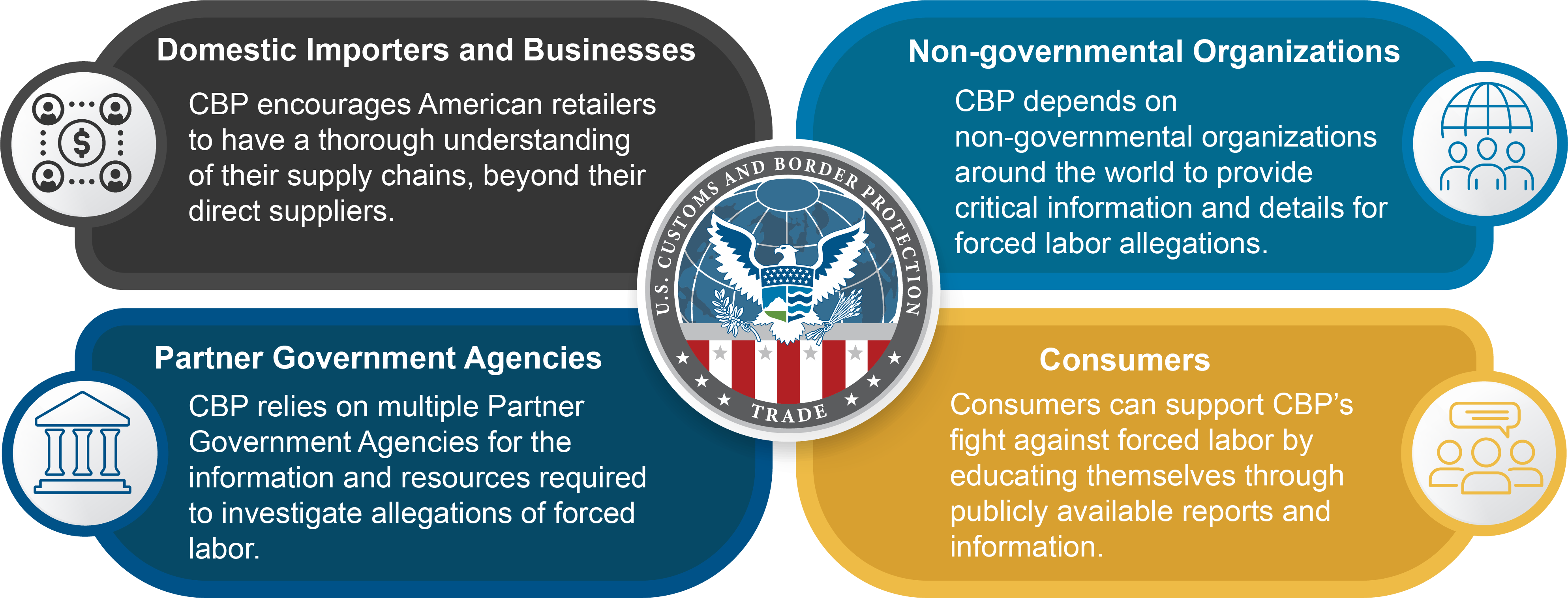Defining Forced Labor | Indicators | Addressing Forced Labor | Allegations | Enforcement Process | WROs and Findings | UFLPA
CBP’s forced labor enforcement mission supports ethical and humane trade while leveling the playing field for U.S. companies that respect fair labor standards. CBP is the only U.S. government agency, and one of the few in the world, with the legal authority to take enforcement action against goods produced with forced labor to prevent entry into domestic commerce.
Forced labor is a violation of basic human rights. CBP is committed to identifying products made by forced labor and preventing them from entering the United States, thereby denying access to the U.S. economy for those that engage in the egregious human rights abuses associated with the use of forced labor.
Eradicating the use of forced labor is a moral imperative. Additionally, forced labor is an unfair trade practice that undermines the ability of companies that treat workers fairly to compete in the global economy. CBP is determined not only to prevent goods made with forced labor from entering the United States, but also to do everything within our authority to stop them from being made in the first place.
How does CBP define Forced Labor?
CBP enforces forced labor trade law under 19 U.S.C. 1307, which defines forced labor as all work or service which is exacted from any person under the menace of any penalty for its nonperformance and for which the worker does not offer work or service voluntarily. This includes forced or indentured child labor.
What are the indicators of Forced Labor?
The indicators listed below were developed by the International Labour Organization. They are intended to help front-line criminal law enforcement officials, inspectors, trade union officers, NGO workers, and others to identify persons who are possibly trapped in a forced labor situation, and who may require urgent assistance. These indicators represent the most common signs that point to the possible existence of forced labor.
ILO indicators of Forced Labor
How does CBP address Forced Labor?
CBP implements Section 307 of the Tariff Act of 1930 (19 U.S.C. §1307) through issuance of Withhold Release Orders (WRO) and Findings, and enforcement of the Uyghur Forced Labor Prevention Act (UFLPA) and Countering America's Adversaries Through Sanctions Act (CAATSA), to prevent merchandise produced in whole or in part in a foreign country using forced labor from being imported into the United States.
CBP is responsible for preventing the entry of products made with forced labor into the U.S. market by investigating and acting upon allegations of forced labor in supply chains.
How to Submit Forced Labor Allegations?
CBP regulations state that any person who has reason to believe that merchandise produced by forced labor is being, or is likely to be, imported into the United States may communicate his belief to any Port Director or the Commissioner of CBP (19 CFR 12.42). To submit information to CBP alleging merchandise was produced with forced labor, please use CBP’s e-Allegations Online Trade Violation Reporting System. While allegations may be reported anonymously, those with a higher rate of successful acceptance for investigations typically provide follow-up contact information for the agency and provide specific and timely information about labor conditions and specific supply chain entities connected to the forced labor. Please reference the allegation submission checklist and recommended guidelines for supporting documentation linked below.
CBP encourages stakeholders in the trade community to closely examine their supply chains to ensure goods imported into the United States are not mined, produced or manufactured, wholly or in part, with prohibited forms of labor, i.e., slave, convict, indentured, forced or indentured child labor.
Forced Labor Enforcement and Our Partners
CBP Forced Labor Enforcement Process
Withhold Release Orders and Findings List
Are your imported goods subject to a WRO or Finding? Check the Withhold Release Orders and Findings List for information on any merchandise that may be subject to exclusion and/or seizure. It is your obligation to be aware of your supply chain activities.
Forced Labor Statistics: Enforcement Actions
The Uyghur Forced Labor Prevention Act
The Uyghur Forced Labor Prevention Act (UFLPA) establishes a rebuttable presumption that the importation of any goods, wares, articles, and merchandise mined, produced, or manufactured wholly or in part in the Xinjiang Uyghur Autonomous Region of the People's Republic of China, or produced by certain entities, is prohibited by Section 307 of the Tariff Act of 1930 and that such goods, wares, articles, and merchandise are not entitled to entry to the United States.
The UFLPA rebuttable presumption went into effect on June 21, 2022. Please visit our UFLPA webpage for all updates on implementation.







